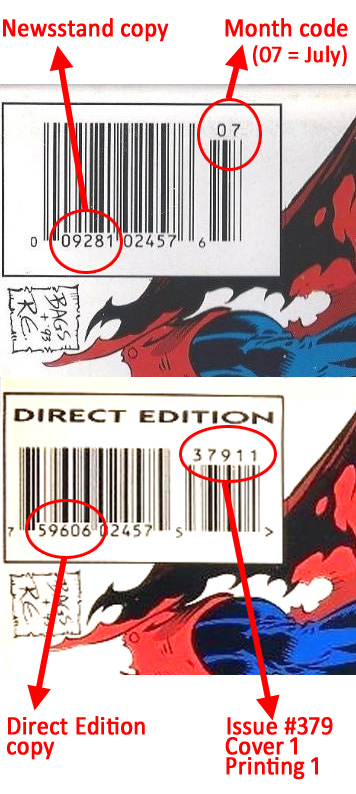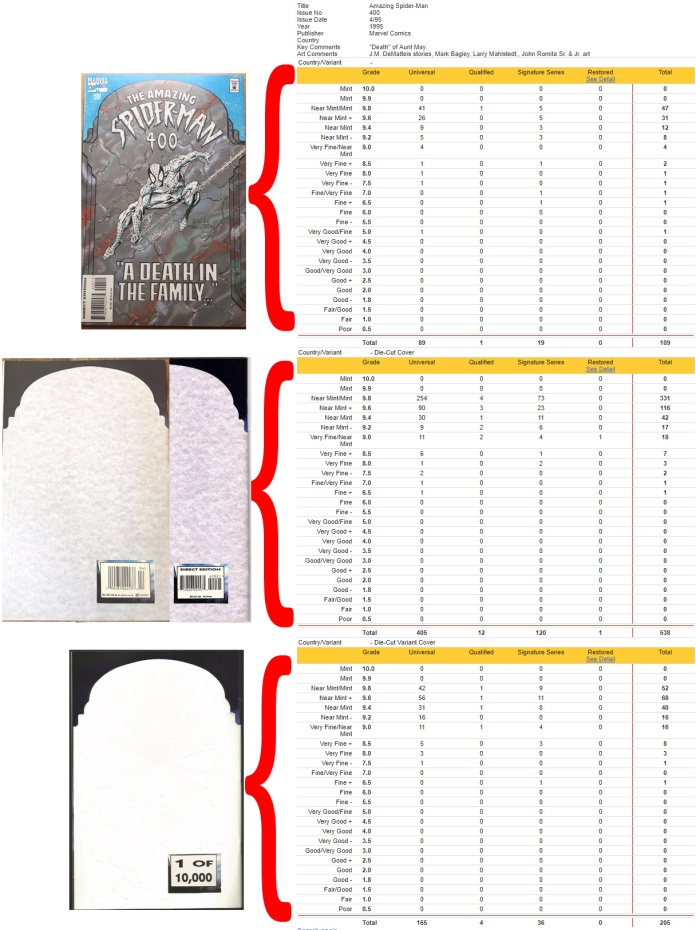By Benjamin Nobel, July 16, 2017
Amazing Spider-Man #400: I’ve been asked about the newsstand edition of this particular Amazing Spider-Man issue so frequently, and I’ve found there is so much misinformation out there about it online and in the marketplace, that I concluded the situation demands a “reference article” that collectors can turn to for information on how to understand the different versions and how to tell a “real” newsstand copy apart from what’s actually just a commonplace regular-cover direct edition copy. But my goal today is to go beyond just giving you the ultimate answer… I want you to understand that answer.
First thing’s first: collectors must understand “the basics” of how to read the code box on a later-modern direct edition copy. [By the way, if you do not yet know about the difference between direct edition and newsstand edition comics, you’ll first want to read my separate post entitled Comic Book Newsstand Editions: Understanding The Difference before proceeding, otherwise it will be hard to follow what comes next.] At issue #379 of Amazing Spider-Man, Marvel switched from denoting their direct edition copies using logos, to using UPC codes that say “Direct Edition” on them:

Amazing Spider-Man #378 direct editions were the last to be denoted by logos; at #379 the direct edition begins to carry a UPC code.
So after this point in time, both the newsstand copies and the direct edition copies of Amazing Spider-Man issues carry UPC codes (albeit different codes). Think about how confusing a situation this created for someone who hadn’t studied newsstand comics in detail: up until the later three-hundreds for Amazing Spider-Man issues it used to be the case that the newsstand edition could always be told apart from the direct edition simply by the existence of a UPC code; in other words, the way it used to work for Marvel’s comics of this era was that if a comic had a UPC code box on it, then it was a newsstand edition. But all of a sudden, Marvel switched things up… and the mere existence of a UPC code from that point on no longer meant that you were definitely looking at a newsstand edition. You had to be able to discern a direct edition bar code from a newsstand bar code!
Let’s take a look at the two versions now, for issue #379. In the picture below, the code at the top is from a newsstand copy, while the code at the bottom is from a direct edition copy. Notice the spots that I’ve circled in red:

The first thing I’d like you to notice is how the first numbers I circled (at the bottom left of the codes) are different from one another. But you needn’t worry about the specific numbers, because, helpfully, the bottom code box also says “Direct Edition” right on it, so you can look for the existence of those words as an easier “visual short-cut” to recognizing you’re looking at a direct edition copy: direct editions say ‘direct edition’ on them (side note: for other publishers you may see other variations of naming convention for denoting direct-market copies such as “direct sales”).

But here’s another short-cut: please notice the second set of numbers I circled, along the top right of the codes. For the newsstand copy, you’ve got a very narrow bar, and just two numbers along the top to denote the month (in this case, 07 for July). But for the direct edition copy you’ve got a wide bar and a lot more numbers. And understanding what these numbers mean is the next piece of background information you’ll need in order to understand the puzzle of the different Amazing Spider-Man #400 versions. So in that second circle on the direct edition copy, the first three numbers are the issue number. So, since this is Amazing Spider-Man #379 we’re looking at, the first three numbers in that circled area are 3, 7, and 9.
After that, you’ll notice two 1’s. The digit immediately following the issue number is used by Marvel to denote different cover variations; the “regular” cover for a comic would be given the number 1. Marvel can then denote other cover variations for the comic, using different numbers. Amazing Spider-Man #379 just has the one cover version, but below I’ll show you an example from Amazing Spider-Man #678 (which I posted on recently and has a cool variant cover), to illustrate how Marvel utilizes this digit to denote alternate covers:

As you can see above, the top copy is the “regular” direct edition copy of Amazing Spider-Man #678 and it has a “1” (circled in red) after the 678; below that is the Mary Jane Venom cover and Marvel has denoted it with a “2” (circled in red).
And then Marvel can use the final digit to denote different printings. An example issue with several different printings is Amazing Spider-Man #700; take a look at the picture below showing first, second, and third print copies:

So: now you understand the basics of these Direct Edition code boxes well enough to make a prediction for what you might see on different types of copies of Amazing Spider-Man #400. Let’s review what different types are out there for issue #400 and then proceed to make such a prediction. We know from various price guides and other online sources that there are three different variations; for example, here’s Overstreet:

Overstreet denotes three versions, the first carrying a $2.95 cover price, the second carrying a $3.95 cover price and denoted as an embossed double cover, and the third denoted as a “Collector’s Edition” with a white cover. Here are those three versions pictured, in a screenshot from over at Atomic Avenue (which taps into the ComicBase system), where they list the same three versions that Overstreet listed out, except in a different order:

As you can see, they have a “regular” cover listed, and then the two embossed versions (one of the two being the white cover version that Overstreet described as the “Collector’s Edition”). And here below is a third guide listing, also showing the same three versions, from ComicsPriceGuide.com:

Once again the same three versions, just listed in a different order. Given what we learned about the Direct Edition code structure, what might we predict to see on these three? Before we answer that, let me rule one out for us, just to make our lives easier: the White/Collector’s version doesn’t have a code (in its place it simply says “1 of 10,000”):

That leaves two versions with bar codes on them: the “plain” cover and the gray embossed cover. Based on what we learned earlier, if both of those are indeed direct editions, we’d expect both would carry the numbers “59606” along the bottom of the code (and the words “Direct Edition”), we’d expect the numbers along the right-hand side of the codes to start with 400 (since this is issue number 400), then after the 400 one of the copies would carry “1” for the cover variation and the other would carry “2” and since these are all first print copies the final number would be a “1” … so in summary, our prediction would be that the “regular” direct edition would carry the numbers 40011 and the “alternate cover” would carry the numbers 40021. In looking at the two, it seems fairly logical that the special/more-expensive “embossed” version would be the “alternate” cover… while the plain/lower-cover-price version would be the “regular” cover, would it not? (While I’m sure there are exceptions out there in the ordering of which is ‘1’ out of a plain/enhanced pair, let’s make that most-logical “first guess” and see if we’re correct that the plain cover is ‘1’ in this case).
Here’s the two versions below zoomed out to show the full front and back covers (for the embossed version the code is on the back) and then let’s zoom in on the circled code boxes and see if our prediction is right (we predicted that the top copy as the “regular” version would carry the numbers 40011, and the bottom copy would carry the numbers 40021, if these are in fact both direct editions).

You can already make out the words “Direct Edition” on each of these zoomed-out pictures, and indeed, when we zoom in we can confirm that both are indeed direct editions, and our prediction for the codes was correct (shown first is the top copy zoom-in; shown underneath is the bottom copy zoom-in):

Confirmed: both say Direct Edition, both carry the numbers 59606 along the bottom, and the codes along the top right are 40011 for the “regular” copy and 40021 for the embossed copy (and as we saw earlier, the “Collector’s Edition” with white embossed cover has “1 of 10,000” in place of the UPC code box).
So if these are direct editions, why are people out there referring to the “regular” direct edition as a newsstand edition, and, what is the “real” newsstand edition?
Let’s examine that first question: why are people inaccurately referring to “regular cover” direct edition copies as newsstand editions? One factor that likely plays a part in the confusion is that an “enhanced cover” seems like something that would be available in comic shops, leaving the “plain cover” as something that seems like it would be what was available on newsstands. And there’s another factor that may add further to the confusion: I contend that the confusion is likely also related to the “switch-over” from direct editions being denoted by logos, to denoted by UPC codes, combined with the fact that the embossed edition has its UPC code on the back cover.
So therefore, “at a glance”, anyone looking at the front of the pair sees one type that apparently lacks a bar code (because for the embossed version that code is “around the corner” on the back and out of sight), and another type that has a bar code… And remember, before issue #379, that pattern meant the bar-coded copy was the newsstand copy; in other words, it used to be the case that shown two copies, one with bar code and one not, that meant one could conclude the bar coded copy was the newsstand type. So this would be a very easy mistake for someone to make, who hasn’t really studied the bar code in detail (of course, in making this mistake, someone would have also had to overlook the words “Direct Edition” on the code box). And that exact mistake appears to be what happened over at MyComicShop, which inaccurately describes the regular-cover direct edition copies as newsstand edition copies, in error, on their site (and numbers them 400N when listing them for sale including on eBay, following their newsstand-numbering-convention):

Notice in the screenshot above how they describe the regular-cover direct edition with the words “newsstand edition” (and they also have an error for the date for that #400N entry, mistakenly cataloging the book under April 1994 instead of 1995). So is this the “culprit”? I.e. the misinformation source that causes so many collectors to describe their direct edition regular copies as the newsstand edition? Or did MyComicShop simply transcribe this bad info from somewhere else? Who knows; it is listed improperly all over the Internet now, so it is hard to trace it back to one particular source… here for example is Amazon.com, also with the regular direct edition copies inaccurately titled “newsstand edition”:

And the “false newsstand edition” is all over eBay too. All of this misinformation out there certainly helps to explain why this particular issue has generated so many questions from readers, who are hoping to understand what’s what… and understand what the “true” newsstand edition looks like.
What does the “true” newsstand edition look like for issue #400? The only type that I’ve ever seen for issue #400 carrying a newsstand distribution code on it is the embossed type. And it is frustrating to spot, because most sellers don’t bother to picture the back cover of their copy… which of course is where the UPC code lives for this particular issue [side note: newsstand copies of Spawn Batman have this same frustrating phenomenon: the UPC code is on the back cover making it especially difficult to find newsstand copies in the marketplace]. But look hard enough, and message enough sellers asking them to picture the back cover, and you’ll eventually find one; they look like this on the back:

Real newsstand copy of Amazing Spider-Man #400
And here’s a zoomed-in side-by-side look at the code boxes of direct edition and newsstand edition embossed-cover copies:

Another related question that comes up with all these different versions is whether CGC denotes them separately on census? CGC “lumps together” the two above embossed-cover direct edition and newsstand versions… because there is no “variant-worthy attribute” in their eyes, to break them apart — we can tell them apart by their code boxes, but the UPC code difference alone is not enough for CGC’s view of the newsstand versus direct edition distinction, to discern them as distinct census variants.
By their current policy there needs to be something beyond the “normal” newsstand vs. direct edition difference for them to “break out” the newsstand edition… such as a different cover price between the types (which there isn’t in this case, as both are $3.95 US), or a difference in the manufacturing (which there isn’t in this case), or an error of some type on the newsstand code (which there isn’t in this case). So on the census, “real newsstand” and direct edition embossed-cover copies are therefore “lumped together” and both denoted with the variant designation of “Die-cut cover” (the White copies are meanwhile denoted “Die-cut variant cover” and the “regular” copies are just regular copies).
Here below, to make this more clear, I’ve taken a screenshot of the current census data and then I’ve pictured the corresponding comics to the left of each section:

What about the sales numbers for the different versions? A reader recently suggested I pick up a copy of the 2005 publication, Comics Buyer’s Guide Standard Catalog of Comic Books, which is a 6 lb phone-book-sized publication that includes, among other things, circulation statement numbers and Capital City order numbers. [I get such great suggestions and information from readers! I picked up a library discard copy for a bargain and find this to be a great reference guide, as those early Capital City numbers are not found online anywhere.] The book then also helpfully estimates the percentage of sales that were Capital City orders, which for 1995, it pegs at 24.2% for Marvel.
So from the photo I snapped below, we can see that “regular” copies of issue #400, if they followed the 1995 average for Amazing Spider-Man, would have had total paid circulation of 234,290 copies. And then for the embossed version, breaking out a calculator, we can estimate that if the Capital City number they show was 24.2% of the total sales, then we can extrapolate to 260,227 total copies of the embossed version. And then we know the White version was limited to 10,000.


What about the “real” newsstand edition, the embossed cover version sold on newsstands? Let’s give estimating the sales count of those a shot, but before you read on, I want to urge readers to remember that such estimations are about seeing the forest as opposed to the trees [please also read this related post: The Orange Cat Phenomenon (by the 1980’s, Overstreet Senior Advisor Jon McClure estimates that fully 80% of surviving copies are Direct Editions; just 20% of surviving copies are newsstand) ].
There are a number of newsstand rarity estimates out there for Marvel by year, including an estimate from Chuck Rozanski at 15% newsstand by 1990 and 10% by 1995 for Marvel (that being his “Marvel-wide” estimate), and a BPA audit for 1999 citing 14% newsstand sales at Marvel overall. But such broad Marvel-wide estimates would be inclusive of all comics: picture a scale with two sides, and all the newsstand sales would go on the left, while all the direct sales (inclusive of direct edition exclusives) would go on the right. When you picture this scale, you’re probably picturing comics piled on each side, but those estimates are actually talking about dollars. Turning that into an estimate of copies sold for one specific title (Amazing Spider-Man) is only going to be a ballpark estimate.
So from these broad Marvel-wide ranges by year, if we go to Amazing Spider-Man specifically, something else we can look at is the publisher’s statement numbers (in the above picture, note how it says that issue #400 has the 1994 statement… well, the 1995 statement appeared in issue #407). And that 1995 statement denoted the 234,290 average paid circulation number that we see referenced in the picture above for issue #400.
Marvel’s Amazing Spider-Man paid circulation, at an average of 234,290 for the 1995 statement (October filing date), was down from the average of 353,025 the prior year… which in turn, was down from an average of the 592,442 seen in 1993! The 90’s were some roller-coaster times for Marvel, starting out in a “boom” and then ending in a “bust” (they’d eventually file for bankruptcy reorganization by the end of 1996).
And against these paid circulation numbers we see for 1995, the statement for Amazing Spider-Man also reveals something else, as relates to newsstand distribution, and that’s the return numbers, at an average 159,946 copies returned. Since the direct edition sales were final (discounted and non-returnable), whereas the newsstand distribution channel called for unsold copies of comics to be returnable to the publisher for a refund (after which the returned copies were typically pulped/recycled forward), we know that these return numbers in the statement are fully from the newsstand distribution channel and include no direct editions. And we have learned from industry insiders that Marvel over-produced each issue such that the bulk of newsstand copies didn’t actually sell and were returned, with Chuck Rozanski for example writing that, quote, “it was seldom that a newsstand sold more than 30% of the new comics that they displayed.”
So if one wanted to do some newsstand number crunching and estimation of likely newsstand edition sales for issue #400, it is possible to guesstimate off of those 1995 average return numbers, under different assumptions for the ratio of returns to actual sales: I come to a quick “back-of-the-envelope” range of likely no more than ~69,000 newsstand copies of Amazing Spider-Man #400 sold and likely not much fewer then around ~24,000 copies sold, all assuming of course that sales of issue #400 followed the average.
By the way, check out what happened to the newsstand return numbers towards the end of the 1990s… they fell off the proverbial cliff and crossed into the 5-digits… by 2001-2008 the average return numbers for Amazing Spider-Man fluctuated in a range of just 17,210-42,593 copies (which means the actual newsstand sales were positively minuscule — with numbers like these you can start to understand just why I’m so incredibly fond of late modern newsstand comics, especially the ones CGC does “break out” as variants such as the $2.99 cover price variants from 2003-2006)!
Fun fact: in 1995 when Amazing Spider-Man #400 was sold, this was how you might have connected to the Internet:

It really is quite amazing how much information access and sharing ability collectors have today, versus collectors of past decades. Today, it is possible to gain more knowledge about newsstand comics in one afternoon of reading, than collectors of past decades were able to accumulate over the course of years!
And so with Amazing Spider-Man #400 what for past collectors might have seemed like a situation of a newsstand comic, we collectors of today can very quickly come to understand these bar codes and definitively conclude that the “regular cover” copies of Amazing Spider-Man #400 are not newsstand copies but rather are direct edition copies; and, we can also spot the “real” newsstand copies:

And for all the readers who have contacted me looking for help with this particular issue of Amazing Spider-Man #400 (and anyone else who has stumbled upon this post looking to making sense of the current marketplace information for this issue), I hope that reading this far that you have now learned not only the answer to the puzzle but why that answer is the indisputable truth — in other words, if I’ve done my job here today then you can now explain to another collector just why the regular-cover direct edition is indeed a direct edition… And I applaud you for expanding your newsstand versus direct edition knowledge! 🙂
Extra tidbit: Some sharp-eyed readers may have noticed that for some of the later-year direct edition examples I showed (the #678 and #700), the second set of numbers along the bottom of the bar code on direct edition copies was different from the #379 and #400 examples… with those earlier examples reading “02457” while the later examples reading “04716” in this spot. If you spotted this and wondered why, the answer is that the code switched from 02457 to 04716 on direct edition copies starting at the point of volume #2 issue #1 in January 1999:

I hope you have found this article helpful, and I wish you Happy Collecting! 🙂
– Ben
